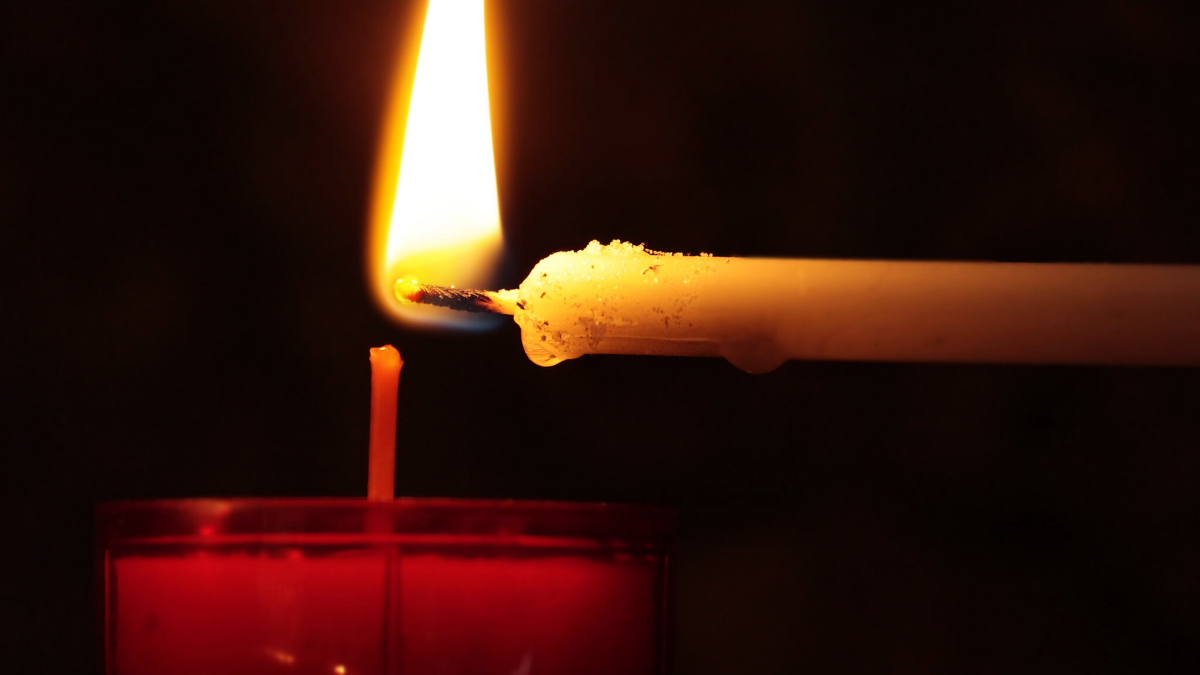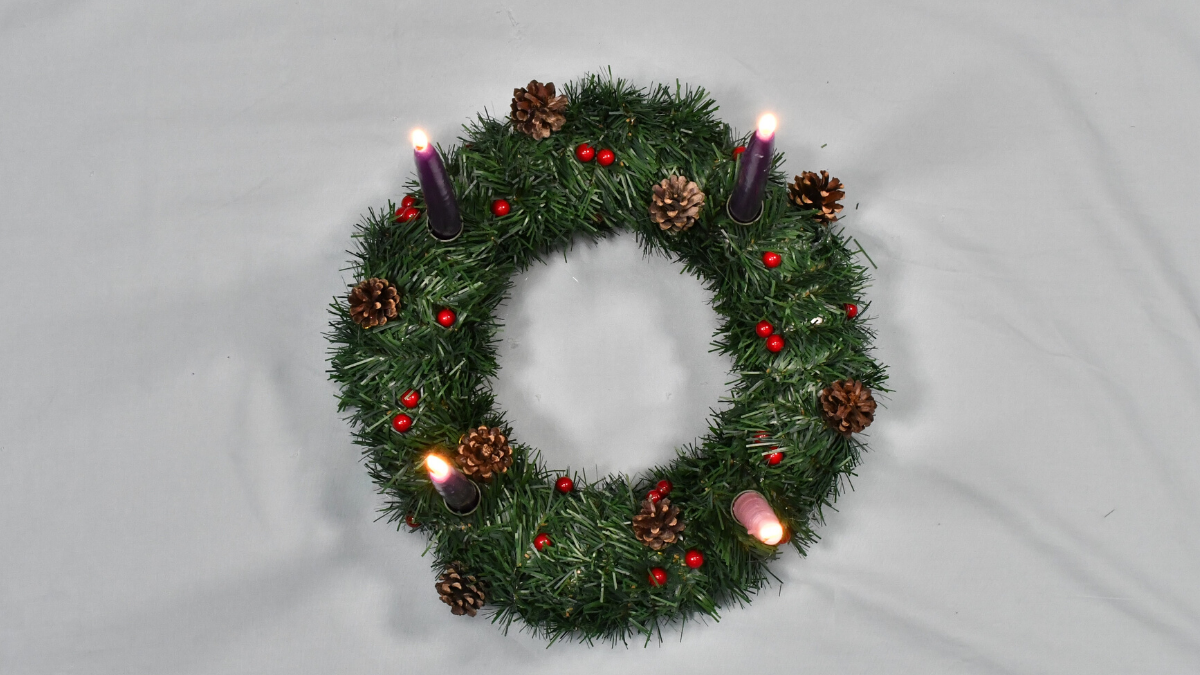Make a Catholic Staint Candle of Someone You Know
Time needed:3 hours and xxx minutes.
Instructions:
- Add together agglutinative to wick clip
Use any adhesive (glue gun, tape, mounting tape) and attach it to the clip terminate of your wick. Then stick the wick to the bottom of your clear jar and concord until it is secure.
- Suspension crayons in half
Don't forget to pare off paper from the crayons first. Break them in half and place in a microwave safe container along with one stick of crisco cut into pieces.
- Put in microwave
Place crayon and crisco mixture into microwave for 2 minutes.
- Add essential oil and stir
Put five or more drops of essential oil (depending on how fragrant you lot'd like the candle to be) into crayon and crisco mixture. Stir until fully mixed.
- Pour mixture into the clear jar
Make sure to hold wick directly and in the middle of the jar while pouring.
- Wrap stop of the wick onto craft stick
To make sure the wick stays in play, wrap end of the wick onto your craft stick and put the candle into the fridge until the mixture hardens.
- Cut wick
If wick is too long, cutting it to your desired size.
- Add large sticker
Place any blazon of large sticker onto outside of the glass jar.
- Light the candle
Enjoy!
Supplies you'll need:
- Crayons
- eleven.3 oz cylinder articulate jar
- x in wick with end clip
- Crisco
- Essential oil
- Agglutinative
- Wooden craft stick
- Large sticker
Candles play an important part in the Catholic Church building and their origins go back centuries.
The symbolism of light has long been used in religious practice, as well as the general usage of candles. In Judaism, a perpetual light was kept burning in the Temple and synagogues to bear witness the presence of God. Candles were also used in Roman pagan culture for religious and military processions, showing the divine favor and presence of the gods.
Christians adapted the employ of lit candles for Mass, liturgical processions, evening prayer ceremonies, funeral processions, and to show reverence to the Blessed Sacrament. It is also likely that candles or oil lamps were burned at the tombs of the saints, specially martyrs.

In the Cosmic church, low-cal has always had a special significance because information technology represents Christ. We know that Jesus called himself the light of the earth. Additionally, St. John'south Gospel connects Christ with the imagery of lite in John one:four: "In him was life; and the life was the calorie-free of men."
With this in mind, we understand why, during the Sacrament of Baptism, the priest presents a candle, which was lit from the Paschal candle, and tells the newly baptized to receive the light of Christ. And at Easter, the Paschal candle is lit as a sign of the risen light of Christ. It cannot be put out, and shines into the globe every bit a symbol of promise and honey.
In our churches today, we light candles before a statue or sacred image of our Lord or a saint. The light signifies our prayer, which is offered in religion, inbound the light of God. Information technology likewise shows reverence and our desire to remain present in prayer even as nosotros continue on our day.
Burning votive candles are a mutual sight in most Cosmic churches. These candles are seen equally an offer that indicates we are seeking some favor from the Lord or the saint before which the votive is placed. Vigil lights are another type of candles burned, and these are typically accompanied by prayers of attending or waiting.
Often, a coin box or basket is located well-nigh these candles where the faithful tin can leave donations to pay for the candles. While this isn't expected of the poor, those who are able should consider leaving a pocket-sized donation to offset the cost.
Lighting a candle for someone is a way to both extend your prayers and prove solidarity with the person the prayer is being fabricated on behalf of. The faithful also light candles equally a sign of gratitude to God for answered prayers.
Many of these candles are traditionally made of beeswax, and in that location is a reason for this. Worker bees who gather nectar from flowers do not play a office in the reproduction of the species. Reproduction is left to the queen bee and drone bees. The virgin worker bees dedicate their lives to the creation of this wax and stand for Our Lady, the virgin female parent who gave birth to Christ. The pure beeswax also represents Christ's pure mankind.

In add-on to the vigil and votive varieties, candles are used in many other ways.
The Paschal Candle, as well known as the Easter candle, is mayhap the well-nigh recognizable because of its size and appearance. This candle is several feet tall and has in colorful designs, in add-on to the year and a cantankerous with five cloves. This candle is used in both the Easter Mass and lit during baptisms throughout the twelvemonth. The candle demonstrates how a new soul and campaigner of light join God'south family.
Chantry candles has been used in Masses since at least the 12th century. These candles remind u.s. of the many persecuted Christians in the first centuries who secretly celebrated Mass at night or in the catacombs by candlelight.
They may also be used in the entrance and recessional processions of Mass and are carried to where the Gospel is read as a sign of triumphant joy in the presence of the words of Christ. The candles used in Mass also serve a more applied purpose: the number lit on the altar also indicates which Mass is being celebrated or even who the primary celebrant is.
Advent candles have an extensive symbolism and are used to create the Appearance wreath that is used in the week leading upward to Christmas. Made upward of 4 candles that represent the four weeks of Advent, one candle is lit each Sunday. 3 of the candles are regal because the color violet is a liturgical color that signifies a fourth dimension of prayer, penance, and sacrifice. The quaternary candle is pink and symbolizes joy.

Candlemas, or the Presentation of Christ in the Temple and the Purification of Mary, is especially rich in symbolism as it relates to candles. When Jesus was presented in the Temple by Mary and Joseph, Simeon gave a famous prophecy almost Christ being a calorie-free to Gentile nations and a sign for the Jewish people.
This led to the church choosing this detail banquet day to accept a special yearly procession and blessing of candles. It is similar to the approving of ashes and palms during Lent and the Easter season. Many true-blue bring candles to this Mass on Feb 2 to be blessed for use at home.
In improver to these special days, candles likewise play a role in the blessing of ashes and palms, the dedication of churches and cemeteries, and the Mass of a newly ordained priest. They are also present at every sacrament except that of Penance.
Throughout all these events, in that location is i common theme: the candles represent Jesus, the true light.
Candles take also played an important role in Mercy Habitation's history. In the 1920s, the Mission Candle Department was established, and our immature men brand rubrical beeswax candles for the clergy. This was function of our long tradition of teaching our immature people marketable skills in the workplace, a special interest of Mercy Home President Monsignor C.J. Quille.
Though candle making is no longer role of our repertoire of internship programs, we keep giving our immature men and women opportunities to learn valuable skills that volition pb them to brilliant futures—a tradition since the early on days of our Home.
Notice More
Source: https://www.mercyhome.org/blog/sunday-mass/why-are-prayer-candles-used-in-the-catholic-church/
0 Response to "Make a Catholic Staint Candle of Someone You Know"
Post a Comment